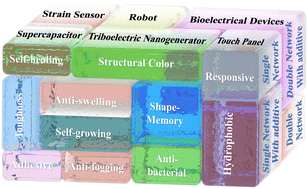Recent advances in conductive hydrogels: classifications, properties, and applications
Abstract
Hydrogel-based conductive materials for smart wearable devices have attracted increasing attention due to their excellent flexibility, versatility, and outstanding biocompatibility. This review presents the recent advances in multifunctional conductive hydrogels for electronic devices. First, conductive hydrogels with different components are discussed, including pure single network hydrogels based on conductive polymers, single network hydrogels with additional conductive additives (i.e., nanoparticles, nanowires, and nanosheets), double network hydrogels based on conductive polymers, and double network hydrogels with additional conductive additives. Second, conductive hydrogels with a variety of functionalities, including self-healing, super toughness, self-growing, adhesive, anti-swelling, antibacterial, structural color, hydrophobic, anti-freezing, shape memory and external stimulus responsiveness are introduced in detail. Third, the applications of hydrogels in flexible devices are illustrated (i.e., strain sensors, supercapacitors, touch panels, triboelectric nanogenerator, bioelectronic devices, and robot). Next, the current challenges facing hydrogels are summarized. Finally, an imaginative but reasonable outlook is given, which aims to drive further development in the future.



 Please wait while we load your content...
Please wait while we load your content...